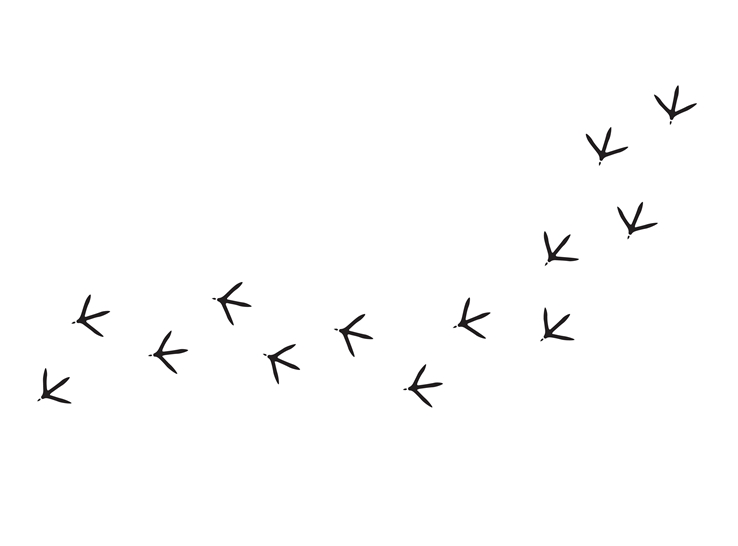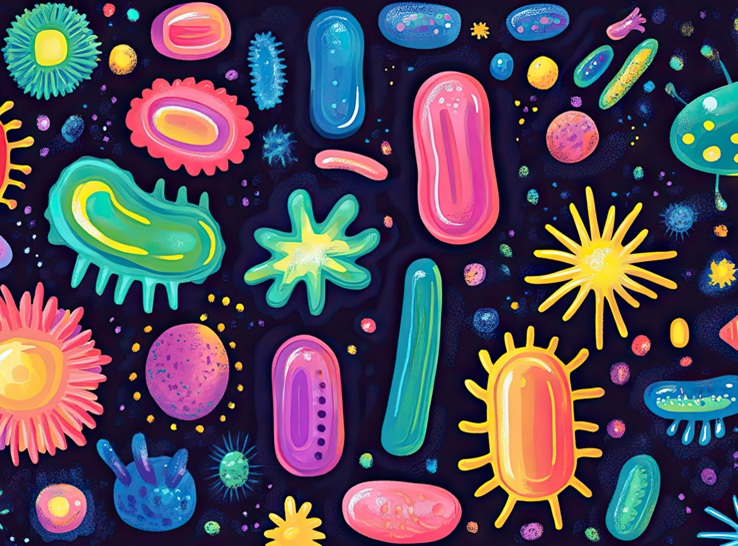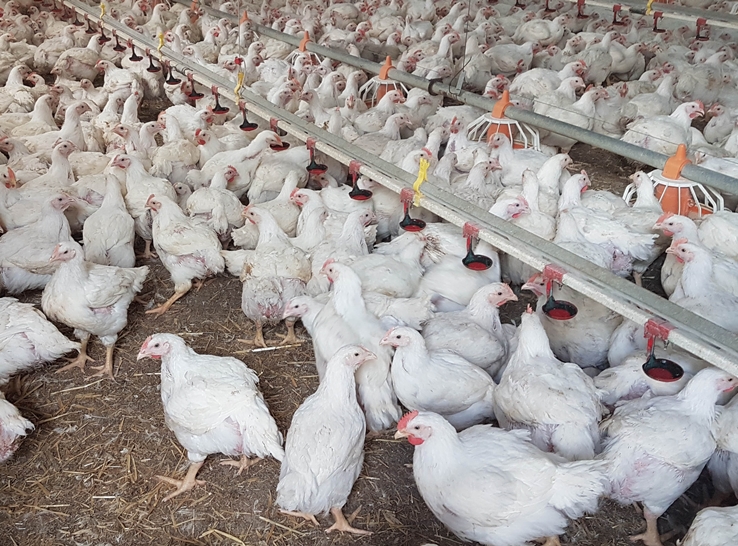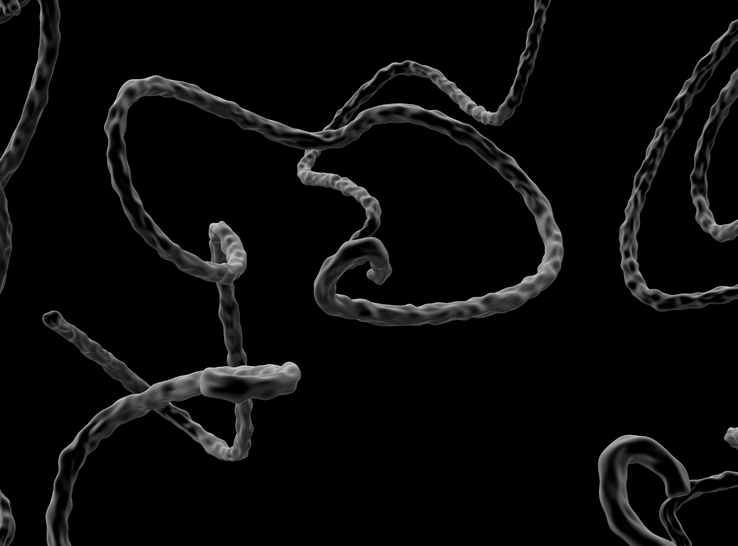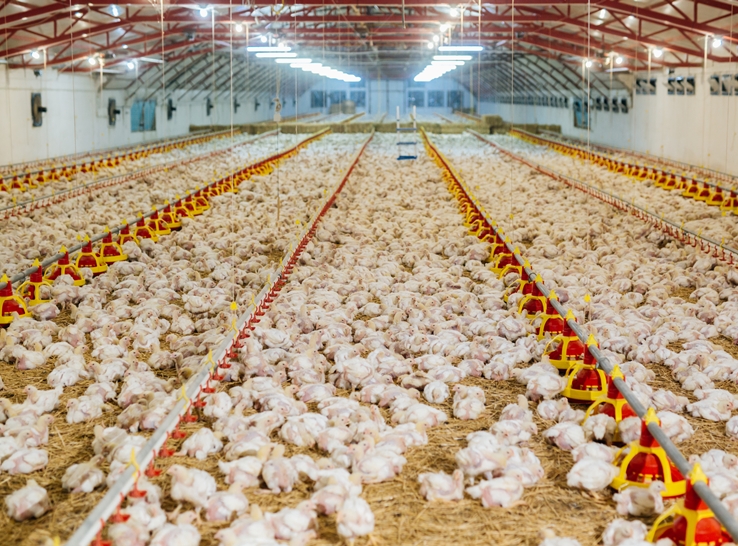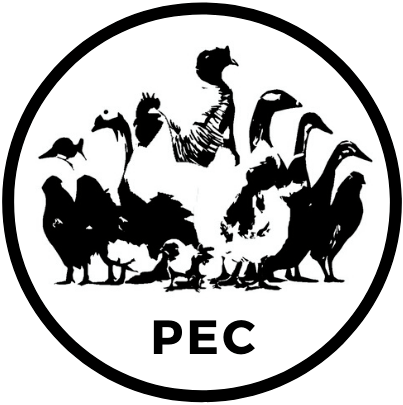By Rosie Whittle, PhD, University of Arkansas
What is the gut microbiome?
- A microbial community, their collective genetic material and metabolites, within the digestive tract of an animal that usually has a symbiotic relationship with the host (Broom and Kogut, 2018)
Why is gut microbiota important?
- Imbalance of the gut microbiota can affect disease resistance, heighten stress and fear responses, and contribute to problematic behaviors such as feather pecking and cannibalism
What makes up the chicken gut microbiota?
- The four most abundant bacterial phyla in the chicken gut are: Firmicutes, Bacteroidetes, Proteobacteria, Actinobacteria (Oakley et al., 2014)
- Beyond bacteria, the gut microbiota also consist of viruses, archaea, fungi, and protozoa. This article will focus on gut bacteria as they are the most abundant microbiota in the gut
Major functions of gut microbiota
- Breakdown of food products (lipids, proteins, and sugars)
- Direct and indirect interaction with host cells to modulate mucosal immune function, enteric nervous system, enterochromaffin cell function (neurotransmitter production)
Firmicutes
-
- Gram-positive*
- Aerobic and anaerobic
- Carbohydrates short-chain fatty acids (SCFA) like butyrate
(Polansky et al., 2016)
Proteobacteria
-
- Gram-negative^
- Aerobic and anaerobic
- Carbohydrates, amino acids, lipids ⟶ SCFA, protein, energy
- Some are opportunistic pathogens (E. coli and Salmonella)
(Rychlik, 2020)
Bacteriodetes
-
- Gram-negative
- Mostly anaerobic
- Complex carbohydrates ⟶ SCFA (acetate, propionate)
(Polansky et al., 2016)
Actinobacteria
-
- Gram-positive
- Aerobic and anaerobic
- Carbohydrates, amino acids, lipids ⟶ energy and protein
- Important for gut homeostasis
(Binda et al., 2018)
The gut-brain axis
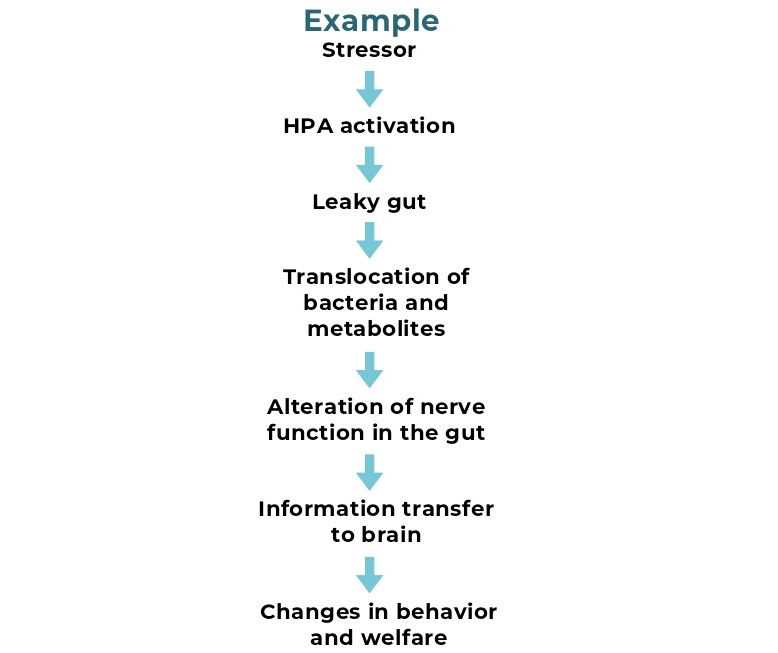 The gut-brain axis is a communication network linking the digestive system and the brain through the nervous, immune, and endocrine systems
The gut-brain axis is a communication network linking the digestive system and the brain through the nervous, immune, and endocrine systems- Gut microbiota can influence behavior, stress responses, and overall health by producing neurotransmitters and metabolites
- Understanding this connection can help improve poultry welfare, reduce stress, and enhance productivity through precision feeding of probiotics
Microbiota imbalance and welfare
- Microbiota imbalance is a reduction in beneficial bacteria and increase harmful bacteria such as E. coli, Campylobacter, and Salmonella (Kogut, 2019)
- Associated with stress and fear responses
- Chronic heat stress decreases the abundance of beneficial bacterial families like Lactobacillus and Bifidobacterium (Lyte et al., 2025)
- Chickens with longer tonic immobility show decreased microbial diversity and fewer beneficial gut bacteria (Gao et al., 2025). For more information on tonic immobility see Poultry Press Vol. 33: Fear Tests in Poultry
- Increases feather pecking and cannibalism risk — high feather pecking birds show altered gut metabolite production (Meyer et al., 2013) and microbiome composition (Birkl et al., 2018). For more information on injurious pecking see Poultry Press Vol. 7: Injurious Pecking Behavior
- There is an association between reduced microbiome diversity and lower cumulative Welfare Quality® scores on commercial broiler farms (Di Marcantonio et al., 2022). This was based on four metrics: good health, good feeding, good housing, and appropriate behavior. High abundance of pathogenic microbiota was also found in lower scoring farms.
Practical strategies to improve gut health
Supplementation with nutraceuticals for microbiota balance
| Prebiotics
Feed ingredients that improve the growth, metabolism and composition of indigenous gut bacteria Commonly used:
|
Probiotics
Live microbial strains that have positive health benefits to host by repopulating gut microbiome with beneficial bacteria. Commonly used strains:
|
Postbiotics
By-products or metabolites of probiotic microbes including proteins, lipids, organic acids. The physiological effects of postbiotics include:
Reuben et al., 2021 |
Other strategies to increase microbiota diversity
- Reducing stocking density (Guardia et al., 2011). For more information on stocking density and welfare see Poultry Press Vol. 39: Stocking density and broiler behavior
- Ensuring good ventilation to minimize thermal stress (Lyte et al., 2025)
- Providing environmental enrichment, e.g. dark brooder (de Jong et al., 2022) or increased environmental complexity (Hubert et al., 2019) can reduce stress response subsequent risk to microbiota diversity. For more information on environmental enrichments see Poultry Press Vol 5: Effective Enrichment Strategies for Broilers and Poultry Press Vol. 57: Effect Enrichments for Broiler Breeders
Summary
- The gut microbiome is a microbial community in an animal’s digestive tract, influencing health and behavior
- In chickens, key bacterial phyla include Firmicutes, Bacteroidetes, Proteobacteria, and Actinobacteria
- The gut-brain axis links microbiota composition to stress responses, behavior, and welfare
- Strategies to improve gut health can include probiotics, prebiotics, postbiotics, and environmental management
References
Broom, L.J., Kogut, M.H. (2018). The role of the gut microbiome in shaping the immune system of chickens. Veterinary Immunology and Immunopathology, 204, 44-51
Oakley, B.B., Lillehoj, H.S., Kogut, M.H., Kim, W.K., Maurer, J.J., Pedroso, A., Lee. M.D., Collett, S.R., Johnson, T.J., Cox, N.A. (2014). The chicken gastrointestinal microbiome. FEMS Microbiology Letters, 360 (2), 100-112. https:// doi.org/10.1111/1574-6968.12608
Polansky, O., Sekelova, Z., Faldynova, M., Sebkova, A., Sisak, F., Rychlik, I. (2016). Important metabolic pathways and biological processes expressed by chicken cecal microbiota. Applied and Enviornmental Microbiology, 82 (5), 1569-1576. https://doi.org/10.1128/AEM.03473-15
Rycklik, I. (2020). Composition and function of chicken gut microbiota. Animals, 10 (1), 103. https://doi.org/10.3390/ani10010103
Binda, C., Lopetuso, L.R., Rizzatti, G., Gibiino, G., Cennamo, V., Gasbarrini, A. (2018). Actinobacteria: A relevant minority for the maintenance of gut homeostasis. Digestive and Liver Disease, 50, 421-428. https://doi.org/10.1016/j.dld.2018.02.012 Bienenstock, J., Kunze, W., Forsythe, P. (2015). Microbiota and the gut-brain axis. Nutrition Reviews, 73 (S1), 28-31. https://doi.org/10.1093/nutrit/nuv019
Kogut, M.H. (2019). The effect of microbiome modulation on the intestinal health of poultry. Animal Feed Science and Technology, 250, 32-40. https://doi.org/10.1016/j.anifeedsci.2018.10.008
Lyte L.M., Jia, X., Caputi, V., Zhang, D., Daniels, K.M., Phillips, G.J., Lyte, M. (2025). Heat stress in chickens induces temporal changes in the cecal microbiome concomitant with host enteric serotonin responses. Poultry Science, 104, 104886. https://doi.org/10.1016/j.psj.2025.104886
Gao, J., Cheng, X., Wu, X., Zou, C., He, B., Ma, W. (2025). Integrated microbiome and metabolomics analysis reveals altered aggressive behaviors in broiler chickens showing difference tonic immobility. Animals, 15 (4), 601. https://doi.org/10.3390/ani15040601
Meyer, B., Zentek, J., Harlander-Matauschek, A, (2013). Differences in intestinal microbial metabolites in laying hens with high and low levels of repetitive feather-pecking behavior
Birkl, P., Bharwani, A., Kjaer, J.B., Kunze, W., McBride, P., Forsythe, P., Harlander-Matauschek, A. (2018). Differences in cecal microbiome of selected high and low feather-pecking laying hens. Poultry Science, 97: 3009-3014 http://dx.doi.org/10.3382/ps/pey167
Di Marcantonio, L., Marotta, F., Poldaliri Vulpiani, M., Sonntag, Q., Iannetti, L., Janowicz, A., Di Serafino, G., Di Giannatale, E., Garofolo, G. (2022). Investigating the cecal microbiota in broiler poultry farms and its potential relationships with animal welfare. Research in Veterinary Science, 144, 115-125
Reuben, R.C., Sarkar, S.L., Roy, P.C., Anwar, A., Hossain, M.A., Jahid, I.K. (2021). Prebiotics, probiotics and postbiotics for sustainable poultry production. World’s Poultry Science Journal, 77 (4), 825-882. https://doi.org/10.1080/00439339.2021.1960234
Guardia, S., Konsak, B., Combes, S., Levenez, F., Cauquil, L., Guillot, J.-F., Moreau-Vauzelle, C., Lessire, M., Juin, H., Gabriel, I. (2011). Effects of stocking density on the growth performance and digestive microbiota of broiler chickens. Poultry Science, 90, 1878-1889. https://doi.org/10.3382/ps.2010-01311
de Jong, I.C., Schokker, D., Gunnink, H., van Wijhe, M., Rebel, J.M.J. (2022). Early life environment affects behavior, welfare, gut microbiome composition, and diversity in broiler chickens. Frontiers in Veterinary Science, 9, 977359. https://doi.org/10.3389/fvets.2022.977359
Hubert, S.M., Al-Ajeeli, M., Bailey, C.A.., Athrey, G. (2019). The role of housing environment and dietary protein source on the gut microbiota of chicken. Animals, 9 (12), 1085. https://doi.org/10.3390/ani9121085
To view all issues of Poultry Press, click here.
Editor’s note: Content on Modern Poultry’s Industry Insights pages is provided and/or commissioned by our sponsors, who assume full responsibility for its accuracy and compliance.
*Gram positive = cell has no outer membrane – more susceptible to antibiotics
^Gram negative = cell has outer membrane – more resistant to antibiotics

